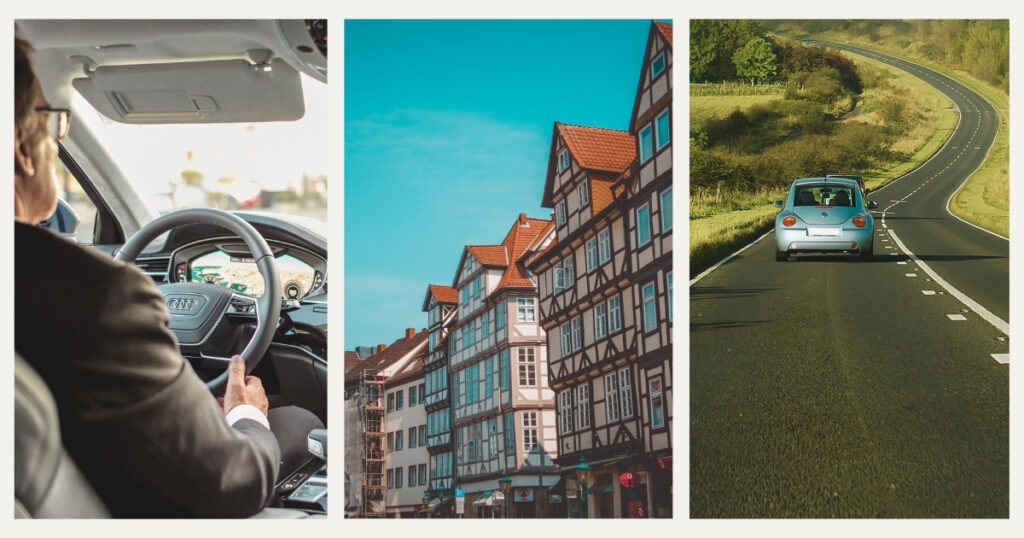Exploring Germany’s picturesque countryside, historic castles, and charming villages becomes infinitely more accessible when you have your own wheels. For digital nomads balancing work and exploration, knowing how to rent a car in Germany can transform your experience from limited to limitless.
From the winding roads of the Black Forest to the stunning castles of Bavaria, Germany offers countless destinations beyond the reach of public transportation. Understanding how to rent a car in Germany ensures you can discover hidden gems while maintaining the flexibility your nomadic lifestyle demands.
In this comprehensive guide, Nomada walks you through everything from rental requirements and costs to insider tips that make the process smooth and stress-free. Whether you’re planning weekend adventures between remote work sessions or a longer road trip across this diverse country, we’ve got you covered.
Understanding car rental requirements in Germany

Before reserving your vehicle, it’s essential to understand the specific requirements for renting a car in Germany. German rental agencies maintain strict protocols that differ somewhat from other European countries, particularly regarding documentation and age restrictions.
Essential documentation
To rent a car in Germany, you’ll need three critical documents: a valid driver’s license, an international driving permit (IDP), and a credit card in the renter’s name. Your home country’s license is typically acceptable if it uses the Latin alphabet, but non-EU visitors should obtain an IDP before arrival as most rental companies require it.
Digital nomads from countries using non-Latin alphabets (such as Japan, China, Russia) must present both their original license and an official IDP. The permit must be obtained in your home country before traveling to Germany, as they cannot be issued once you’ve left your country of residence.
🌟 Pro tip: many German car rental agencies will accept a license without an IDP if it’s in English, but carrying an IDP eliminates potential complications and serves as a universally recognized translation of your driving credentials.
Age and experience requirements
Most rental companies in Germany require drivers to be at least 21 years old, though the minimum age for premium or luxury vehicles is often 25. Additionally, many agencies require you to have held your license for at least one year before renting.
Age-related surcharges apply for drivers under 25, typically ranging from €15-30 per day depending on the company and vehicle class. These “young driver fees” significantly impact total costs, so budget accordingly if you’re in this age bracket. Some premium car categories may be entirely unavailable to drivers under 25, regardless of willingness to pay the surcharge.
💡 Did you know? Unlike some countries, Germany doesn’t typically impose maximum age restrictions for car rentals. Many agencies will rent to drivers over 70 without additional requirements, making it an accessible option for digital nomads of all ages.
How to rent a car in Germany: step-by-step process

Securing a rental car in Germany follows a fairly standardized process, but knowing what to expect at each stage helps avoid surprises. From selection to return, here’s how to rent a car in Germany efficiently.
Researching and booking options
Begin your search well before your intended rental date, especially during peak tourist seasons (June-September) or around major events like Oktoberfest. Comparison sites like Auto Europe, Kayak, or Expedia can provide an overview of available options, but checking directly with rental companies often reveals additional promotions or vehicle availability.
When comparing prices, pay close attention to included insurance coverage, mileage limits, and fuel policies. German rental quotes might appear higher than in neighboring countries because they typically include mandatory third-party liability insurance. However, the Collision Damage Waiver (CDW) and theft protection are often extras worth considering for comprehensive coverage.
Selecting the right vehicle
Germany’s excellent road infrastructure accommodates vehicles of all sizes, but your choice should align with your specific needs. Compact cars work well for urban exploration and offer better fuel efficiency, while station wagons (called “Kombis” in Germany) provide extra space for longer road trips or equipment transport.
Consider transmission type carefully when reserving a vehicle. Manual transmissions are standard in Germany, and automatic cars are typically 15-30% more expensive and must be specifically requested. If you require an automatic, book well in advance as their availability is limited, especially at smaller rental locations or during peak seasons.
🌟 Pro tip: for digital nomads planning to visit neighboring countries, verify cross-border policies before booking. Many German rental contracts allow travel to Western European countries but restrict driving to Eastern European destinations or charge additional fees for cross-border insurance.
Understanding rental costs and fees
Base rental rates in Germany vary widely depending on vehicle class, rental duration, and season. Expect to pay €30-50 per day for economy cars, €60-100 for mid-size vehicles, and €100+ for premium options or vans. Weekly rentals offer substantial discounts, often reducing daily rates by 30-40%.
Beyond the base rate, prepare for potential additional charges including:
- One-way rental fees (€50-150)
- Additional driver fees (€10-15 per day)
- GPS rental (€8-15 per day)
- Winter tire fees during seasonal requirements (Nov-April)
- Airport or train station pickup surcharges (10-20% of total rental)
- Fuel charges if not returning with a full tank
While navigating these fees, ensure your rental includes unlimited kilometers. Limited mileage policies can quickly become expensive given Germany’s vast road network and tempting destinations.
Digital nomad-specific considerations when renting cars in Germany

Digital nomads face unique challenges when renting vehicles in Germany. From connectivity needs to work-friendly features, these considerations help maintain productivity while enjoying the freedom of the open road.
Maintaining connectivity on German roads
Staying connected is essential for digital nomads, even while traveling between destinations. Germany’s mobile coverage is generally excellent in urban areas but can be spotty in rural regions, particularly in parts of the Black Forest, the Alps, and eastern Germany.
A destination-specific eSIM from Holafly ensures you maintain reliable internet access throughout your German road trip without the hassle of purchasing local SIM cards. This solution activates instantly upon arrival and provides data coverage across the country, allowing you to handle urgent work matters even from scenic countryside stops.
Planning work-friendly itineraries
As a digital nomad, balancing exploration with work commitments requires strategic planning. When mapping your German road trip, identify potential work spots along your route, including:
- Coworking spaces in major cities like Berlin, Munich, and Hamburg
- Digital nomad-friendly cafés with reliable WiFi and comfortable seating
- Highway service stations with business facilities (Autohof locations)
- Hotel business centers for printing or emergency connectivity
- Public libraries in larger towns, which often offer free WiFi and quiet workspaces
Key considerations for work-friendly car rental itineraries:
- Allow buffer days between major drives for focused work sessions
- Research accommodation with adequate workspace before arrival
- Schedule driving during non-working hours when possible
- Plan longer stays in cities with established digital nomad communities
- Consider rental vehicles with sufficient space to work comfortably if needed
🌟 Pro tip: reserve accommodations with dedicated workspaces for days following long drives. The combination of road fatigue and work pressure can significantly impact productivity, so ensure your stopping points have comfortable setups for catching up on projects.
Navigating German roads: essential knowledge

Understanding German road rules and driving culture is crucial when planning how to rent a car in Germany. The country’s famous Autobahn and precise traffic regulations require specific knowledge for safe and legal driving.
Autobahn driving guidelines
Germany’s Autobahn network is legendary, but it comes with its own set of rules. Contrary to popular belief, not all sections are without speed limits. Only segments marked with a white circular sign featuring five black diagonal lines have no specific speed limit, though the recommended maximum is 130 km/h (81 mph).
The left lane is strictly for passing, and “rechts fahren” (keep right) is a fundamental rule. Always return to the right lane after overtaking, as lingering in the left lane is both illegal and considered poor driving etiquette. Rapid flashing of headlights from vehicles behind you, while seemingly aggressive to foreigners, is a standard signal requesting you to move right to allow passing.
Understanding road signs and rules
German road signs use a standardized European system with some unique elements. Red circular signs indicate prohibitions, blue signs provide information, and triangular signs warn of potential hazards. Speed limits are displayed in kilometers per hour within red circles.
Environmental zones (Umweltzonen) exist in many German cities, requiring vehicles to display appropriate emissions stickers. When renting, confirm your vehicle has the correct sticker for areas you plan to visit. Major rental companies typically provide appropriately certified vehicles, but always verify this before accepting the car if your itinerary includes city centers.
Final thoughts on how to rent a car in Germany
Renting a car in Germany offers digital nomads unparalleled flexibility to combine productive work periods with immersive explorations of this diverse country. From the efficiency of the booking process to the excellence of German road infrastructure, the experience typically exceeds expectations for international visitors.
Understanding how to rent a car in Germany involves preparation with proper documentation, awareness of local driving regulations, and strategic planning that accommodates both your work schedule and travel aspirations. The freedom to discover charming villages, stunning landscapes, and historic sites at your own pace makes the effort worthwhile.
Whether you’re planning weekend excursions between remote work sessions or a comprehensive cross-country journey, a rental car transforms your German digital nomad experience from city-bound to boundless. With proper preparation and the right vehicle, Germany’s remarkable diversity becomes your extended office and playground.
For more tips on transport options as you travel through Europe, check out our comprehensive guide to transportation for digital nomads, covering everything from public transit to ridesharing alternatives.
Your German road adventure awaits with Nomada as your companion 👉
Stay connected while you travel with Holafly’s eSIM 🌍
Getting ready for a trip and want to forget about roaming charges, physical SIM cards, or unreliable public WiFi? With Holafly’s eSIM, staying online in over 160 countries is easier than ever.
With Holafly, you’ll enjoy:
📲 Instant activation: just scan a QR code and you’ll have data at your destination.
🌐 Global coverage: available in 160+ countries, including top tourist spots and major business hubs.
📅 Flexible plans: choose daily, weekly, or monthly options based on your travel needs.
❌ No physical SIM required: keep your current SIM in place, no local procedures needed.
💬 Multilingual support: get fast, clear assistance whenever you need it.
Browse securely without relying on public networks, access maps, apps, bookings, and work remotely without interruptions.
Set it up once and easily pause or switch profiles as needed, saving battery and managing your data usage.
📵 Say goodbye to roaming fees and hello to a simple, secure connection—without surprises on your bill.
Does your phone support eSIM? Then Holafly is the perfect travel companion to stay connected wherever you go.
Frequently asked questions about how to rent a car in Germany
If your license uses the Latin alphabet, you may not need an IDP, but it’s recommended. Non-EU licenses in non-Latin scripts (Arabic, Cyrillic, etc.) definitely require an IDP. Always obtain this document before leaving your home country.
Most rental companies require drivers to be at least 21 years old with one year of driving experience. Drivers under 25 typically pay daily young driver surcharges ranging from €15-30, and may face restrictions on available vehicle categories.
Most rental companies allow travel to neighboring Western European countries, but policies vary for Eastern European destinations. Cross-border travel must be declared when booking, and additional fees may apply for international insurance coverage.
Yes, but they’re less common and more expensive (15-30% higher) than manual transmission vehicles. Book well in advance if you require an automatic, especially during peak tourist seasons when availability becomes limited.
Basic liability insurance is mandatory and included in rental rates. However, adding Collision Damage Waiver (CDW) and theft protection is highly recommended. Check if your credit card offers rental coverage to avoid duplicating protection and unnecessary expenses.




